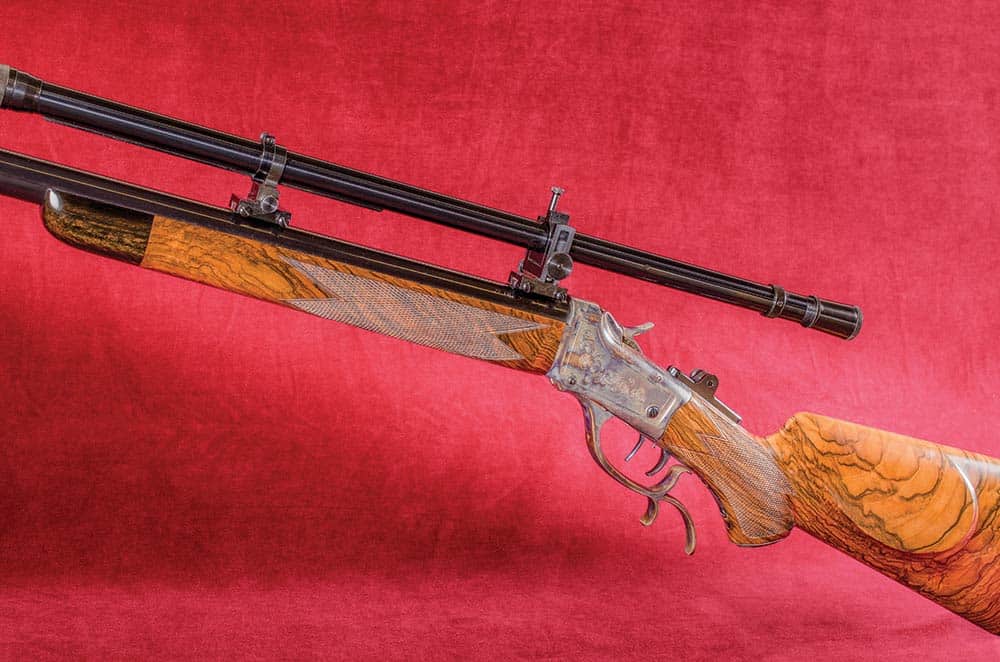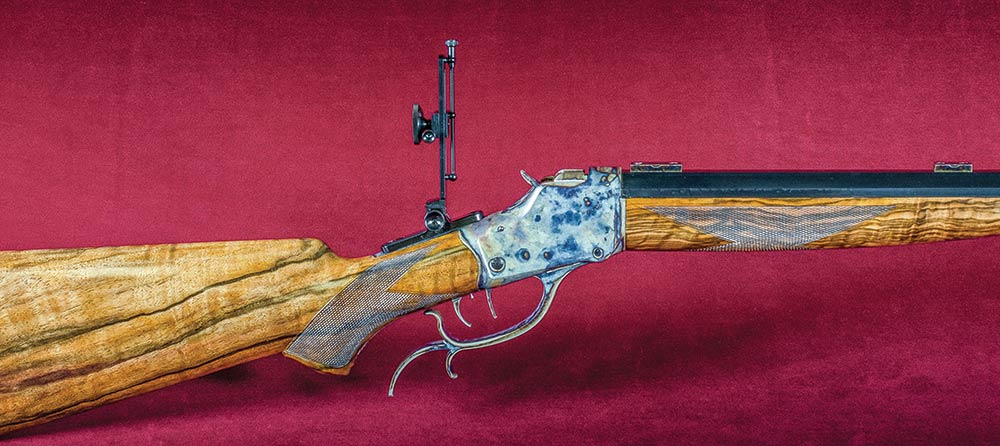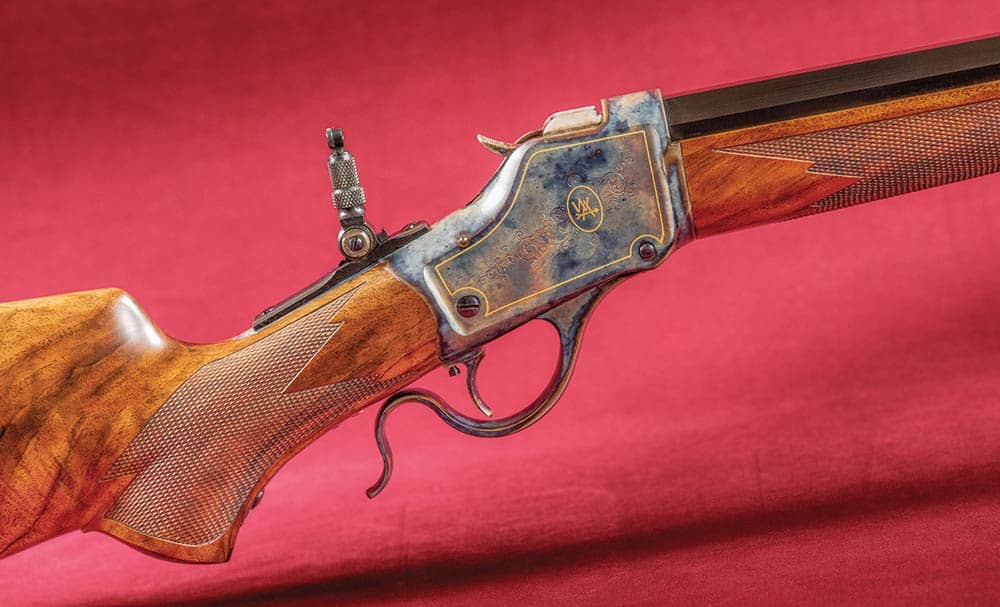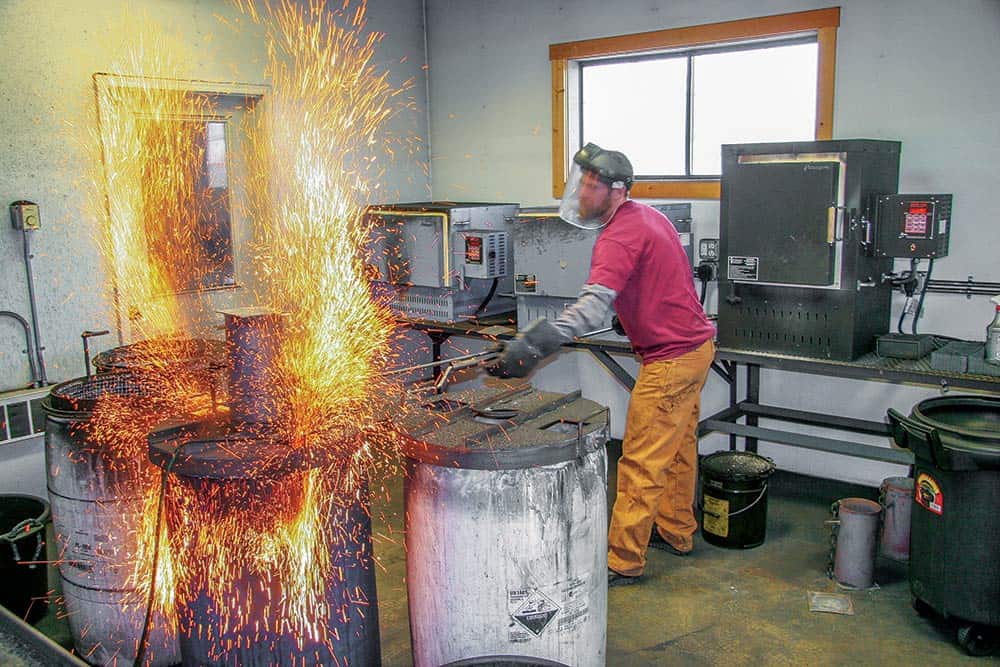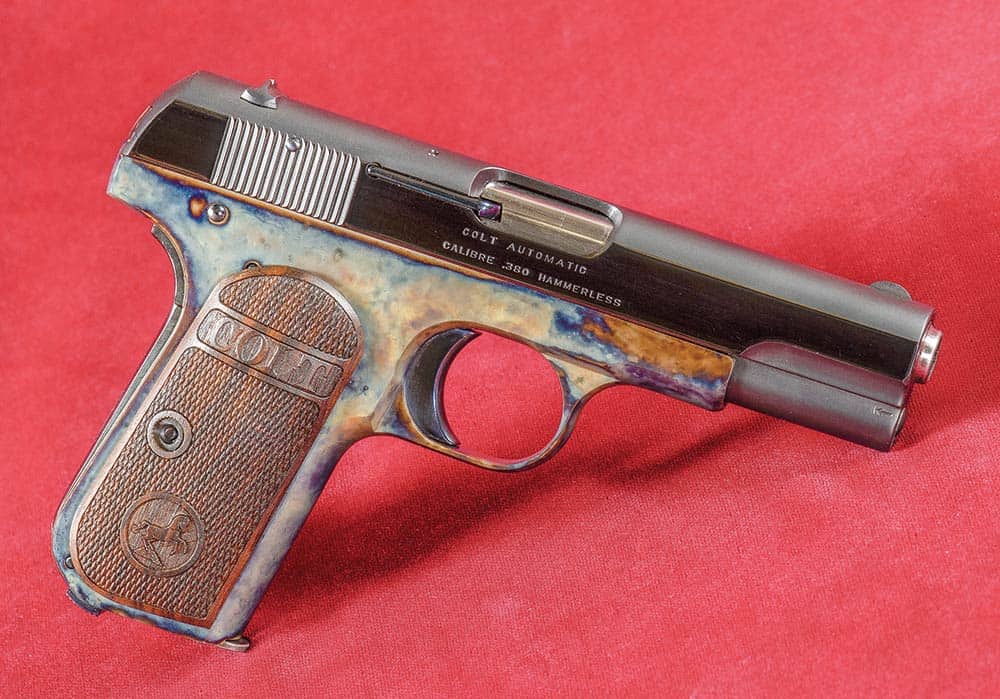Wyoming Armory
Precision Firearms
This MVA 10-power “A” competition scope sits in Malcolm Silhouette Vernier Mounts. The rifle, chambered for .22 LR, is for 22 BPCR silhouette competition. Photo: George Dillman
Today you can purchase more rifle accuracy over the counter at Walmart than could be custom-built 30 years ago. However, it’s likely your “Big-Box” gun will have been “assembled” rather than “fitted” — largely with synthetic components.
This is good news for pragmatists who view firearms primarily as tools but less so for traditionalists who love the classic wood and steel of their grandfather’s sporting arms.
An MVA No. 108 Sharps Mid-Range Vernier Tang sight, double-set triggers and Schuetzen/Helm lever highlight this 1886. Photo: George Dillman
A Superior Single Shot
For those seeking such a timeless, heirloom firearm, a great source is Wyoming Armory Precision Firearms (WAPF), located in Cody, WY. If you’re a fan of Gun Stories with Joe Mantegna, you’ve seen Wyoming’s co-owner and managing partner, George Dillman, on the show.
George, a former Green Beret, firefighter, paramedic, police officer, firearms instructor, competitive shooter, historian and businessman is a true Renaissance man. In 2015 he and a partner bought the capital assets of Wyoming Armory when it went out of business and started WAPF, a full service shop specializing in one-off 1885 Winchesters.
The 1885 was the creation of John Moses Browning who was granted his first patent in 1879 for a single-shot, falling-block rifle he and his brothers were making by hand. In 1883, Winchester purchased the design, made some slight modifications and brought the gun to market as the Model 1885. The action was so robust Winchester used it when testing new cartridges.
With the buffalo herds already on the verge of extinction thanks to hunters using single-shot rifles produced by companies such as Maynard, Ballard, Remington, Springfield and especially Sharps, Winchester needed an arena in which to compete. It discovered one in the fledgling sport of long-range competition such as Creedmoor and Schuetzenfest events.
While Dillman is the guiding force, the backbone of the company is Keith Kilby, a former employee of the Ballard Rifle and Cartridge Company. Kilby (with assistance from other WAPF gunsmiths) took an original 1885 High Wall to Montana Vintage Arms (MVA) and got them to reproduce it.
Today, the 1885s produced by WAPF are composed of actions and parts (sans barrels and stocks) from either original High or Low Wall Winchester 1885s or MVA reproductions (High Wall only). These are not over-the-counter production rifles and made entirely to the customer’s specifications. No two firearms produced by WAPF have ever been exactly alike.
As the originals were chambered for rimmed cartridges, so are these new 1885s. Modern Japanese reproductions in the guise of Herstal FN (Brownings and Winchesters) are available in modern rimless cartridges but they are mechanically quite different from the original 1885, especially the trigger mechanism.
As per the originals, WAPF 1885s are available with either a single trigger, a single-set trigger or a double-set-trigger. The action lever is incorporated into the trigger guard and is shaped like the letter “S” for rifles with a single trigger. The double-set trigger requires a Long-S lever to provide room for the extra trigger. And Schuetzen/Helm levers are available that add two flanges for finger placement.
Unless the customer specifies otherwise, WAPF uses Douglas, Kreiger, Benchmark or Shilen barrels depending upon the caliber, twist-rate and barrel configuration chosen. Full-length octagonal is the most popular choice followed by half octagonal/half round and, finally, full-length round. Matte, Satin, Gloss or High Gloss finishes are available. Their most requested calibers are .45/70 and .22 LR.
In .45/70, their guns usually shoot sub-MOA with Remington factory jacketed ammo. According to Dillman, it’s trickier to develop an accurate handload for black powder cartridges and they will work with their customers to develop an accurate load for their specific rifle.
They acquire semi-inletted stocks in the rough from Treebone Carving of Wellington, NV. Original 1885s were produced with American Black Walnut stocks and WAPF offers the additional option of English Walnut, both of which are available in “Semi-Fancy” grade up to (as George describes it) “The Sky’s The Limit” grade.
Cheekpieces, either right or left hand, are available with the borders blended or beaded. Customers can choose a straight or pistol grip stock either smooth or checkered. A traditional ebony inlay in the pistol grip and forend tip are standard. Butt configuration options are Shotgun (flat), Crescent or fitted with the Swiss/Helm/Schuetzen buttplates.
According to Kilby, their primary market is Black Powder Rifle Cartridge Silhouette shooting, although their rifles see frequent service in BPRC Long Range, Creedmoor, Schuetzen and Buffalo matches. Competition held under the auspices of the American Single Shot Rifle Association (ASSRA) while the Cast Bullet Association (CBA) and the .22 BPCR Association are also fertile markets.
MVA’s Vernier or Soule Tang sights are typically selected; it’s rare a customer chooses a barrel-mounted rear sight. Winchester-style Globe front sights — with or without a bubble level — are the most popular front sight option. MVA’s Winchester “B” Series scope or one of MVA’s longer vintage type scopes with Malcolm-style Vernier mounts are the most popular optics chosen. Should the customer prefer a modern scope, a custom quarter rib can be added to mount it.
George dropped this trophy bull bison with one shot from his Model 1885 rifle shooting a .50-90 Sharps black powder cartridge. The scope is an MVA “B” series.
This Wyoming 1885 Winchester sports an MVA Winchester Rear Combo sight and a single-set trigger. Photo: George Dillman
Embellishments Abound
The action itself can be blued as an option but WAPF has mastered spectacular bone charcoal color case hardening. Kilby refined their process to the extent they can actually bias the resultant hues to match the customer’s desires. While case hardening does harden the surface of the metal, it is susceptible to wear and ultraviolet light, both of which — over time — will mute the colorful appearance. As an option, WAPF can apply a transparent coating to the newly case hardened surface, which protects and enhances the intensity of the colors.
Kilby is also an accomplished engraver. The sides of the 1885 action, especially the High Wall, are relatively large expanses of flat, open metal providing a perfect canvas for engraving. As an added option, WAPF will engrave the receiver to any point, including the aforementioned “Sky’s the Limit.”
Prices on the 1885s start at about $4,400 if Wyoming provides all of the parts and can escalate quickly from there depending upon embellishments.
If your definition of “fine art” includes a painting of dogs playing poker or a depiction of Elvis rendered on a velvet canvas, then Wyoming Armory Precision Firearms may not be for you. However, if you have a refined sense of appreciation for art made from steel and wood, they can produce a rifle that can be as functional as it is breathtaking.
After removing the bone and charcoal encased parts from the oven, Wyoming’s Josh Wittick dumps them into the bath tanks for cooling.
The result — as with this Marlin receiver — is a spectacular array of colors and a hardened surface.
Bolt-Action Options
Besides 1885 Winchesters, WAPF also produces impressive bolt-action rifles that are capable of 1/2 MOA. Kilby and Dillman are both competitive shooters and are classified as Masters in F-Class Long Range, giving them added insight into what works and what’s gimmickry.
Like their 1885s, their bolt guns start from a blank canvas and are built to a customer’s specifications. While they work with a number of different custom actions, they mostly use Remington 700s due to the aftermarket parts availability. Kilby surprised me by saying they find the new bare actions coming from the Remington factory in North Carolina better than the old ones made for years at the Ilion, NY plant. This opinion runs counter to popular recent criticism of Remington’s quality control.
Unless the customer specifies otherwise, Kilby and Dillman recommend the use of Bartlein, Kreiger or Pac-Nor barrels, Manners, McMillan, H-S Precision or Bell and Carlson stocks along with Timney Calvin Elite or Bix’n Andy triggers. All, needless to say, are top-shelf, high-end components.
Depending upon the caliber selected by the customer, if they have the loading dies and brass available, they will load-test ammunition and ship the rifle with a test target and data for a good starting load.
If Wyoming Armory provides all of the parts for the custom-build, prices on the bolt action rifles from Wyoming Amory Precision Firearms start at approximately $2,400 depending upon the options chosen.
This Colt M1908 Pocket Hammerless .380 features polished slide flats, bone charcoal color case hardening and clear coating; the trigger, extractor, controls and screws are nitre blued.
Handguns Upgraded
In addition to creating superb rifles, Wyoming Armory Precision Firearms is also a full service gunshop. According to Kilby, they alter many factory finishes on firearms of all types. They do all of the case-color hardening for Big Horn Armory, Joe Perkins’ Classic Single Action, Precision Small Arms and they also do hammers for John Linebaugh. I had them case-color harden the frames of a 1911 and a CZ Shadow 2 and re-blue the slides and nitre-blue the grip screws, safety and slide stop levers of the CZ. The work is stunning. Case hardening frames runs $95 plus an additional $50 if you opt to have it clear coated.
